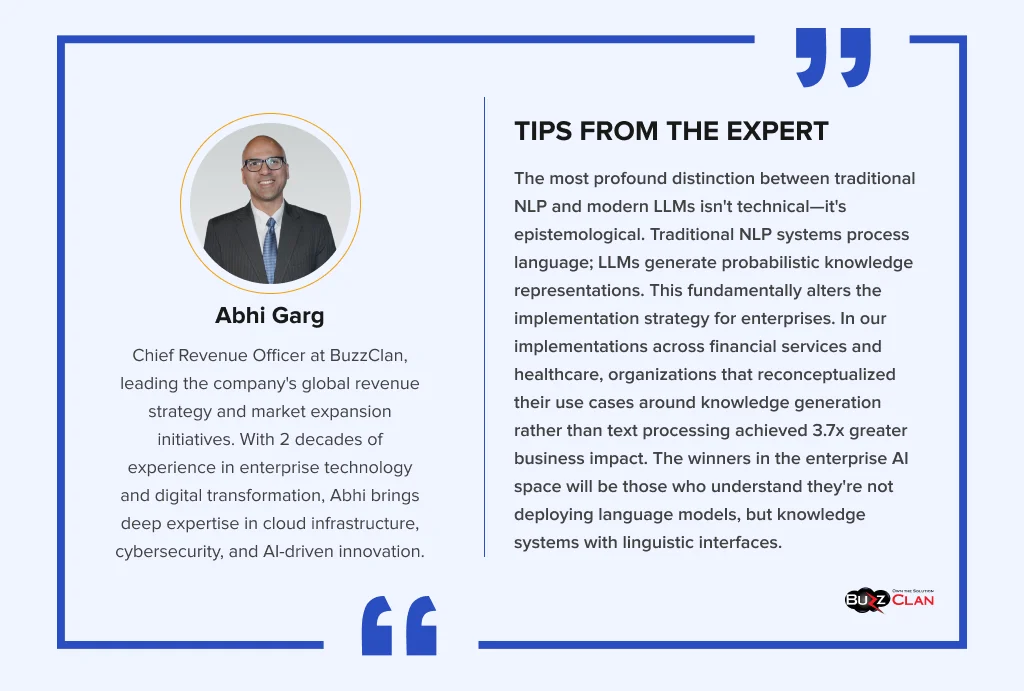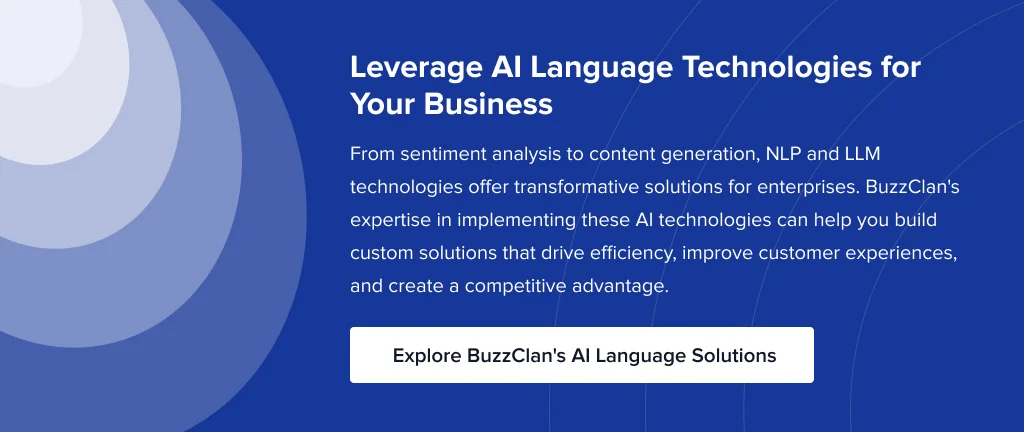NLP vs LLM: What’s the Difference and Why It’s Important for Your Business
Deepak Desai
Jun 26, 2025
What is Natural Language Processing (NLP)?
Natural language processing (NLP) is a branch of AI and computer science that teaches computers to understand our natural language. Computers use NLP techniques, technologies, and tools to understand, interpret, and produce human language. It is the basic foundation of the chatbots or virtual assistants we use today.
These are like translators that translate computer gibberish into comprehensive human texts. Many technologies are combined, so computers can create the same language humans use. Some of these technologies are as follows:
- Semantic analysis
- Content creation
- Text classification
- Sentiment analysis
- Named Entity Recognition (NER)
What are Large Language Models (LLMs)?
A subset of NLP, LLMs are huge and advanced AI models. These models analyze data and produce content in texts and languages. They are fed tens of millions of pieces of information regarding multiple factors from the Internet or traditional sources. The LLMs then use this information to train themselves and provide understandable and factually accurate knowledge. This stage is also known as pre-training.
LLMs, like GPT (Generative Pre-trained Transformer) and BERT (Bidirectional Encoder Representations from Transformers), are built on the transformer architecture. This neural network architecture focuses on self-attention mechanisms that help combine words according to how they accurately make sense with words in a sentence.
LLMs have many uses, such as virtual assistants (Siri, Alexa) and chatbots (ChatGPT, Bard), making our lives convenient with coherent content. Here are some of them:
- Audio Data Analysis: Modern audio data analysis techniques eliminate the necessity for hours-long manual work on audio extraction tasks. LLM technology can enhance efficiency levels through generated summaries. LLMs enable users to extract the essential information from audio recordings of meetings, phone calls, videos, or podcasts.
- Customer Sentiment Analysis: Large language models achieve superior capabilities to analyze customer sentiments while processing their reviews, feedback, and communication data. Website chatbots designed with these capabilities enable better customer need recognition, which results in improved user experiences. Analyzing customer sentiments enables companies to maintain their clients through enhanced personalized recommendations.
- Content Creation: LLMs follow specified user preferences, making content creation and modification tasks possible through their vast data. Various chatbots, including Grok, Gemini, and Claude, perform self-training through large language models to deliver precise, fast, and understandable information.
NLP vs LLM: Key Differences
NLP vs LLM. Although they are from the same branch, they consist of several differences. In this comprehensive review, we have taken basic to advanced key differences. Let’s look at them for a thorough understanding:
| Feature | Natural Language Processing (NLP) | Large Language Models (LLMs) |
|---|---|---|
| Definition | The AI field enables computers to understand human language | Massive neural networks generating human-like text |
| Architecture | Various algorithms (rule-based, statistical, ML) | Primarily transformer-based with attention mechanisms |
| Approach | Task-specific models for defined language problems | General-purpose models learning from extensive data |
| Scope | Focused on specific tasks (translation, sentiment analysis) | Handles multiple language tasks simultaneously |
| Data Requirements | Can work with smaller, specialized datasets | Requires massive datasets (hundreds of GB to TB) |
| Context Handling | Limited context window; often sentence-by-sentence | Understands context across thousands of tokens |
| Compute Resources | Can run on standard hardware for many applications | Requires significant GPU/TPU resources |
| Text Generation | Basic generation with templates or statistical methods | Sophisticated, human-like generation |
| Implementation | Distinct models/pipelines for different tasks | Single model adaptable through prompting or fine-tuning |
| Examples | NLTK, spaCy, Stanford NLP, traditional MT systems | GPT-4, Claude, LLaMA, PaLM, Gemini |
How LLM and NLP Work Together
Think of it this way: NLP is like teaching a computer to read a storybook, while an LLM is like teaching a computer to write a whole new storybook!
- These technological combinations enhance the flexibility and adaptability attributes of artificial intelligence applications. Their ability to adapt improves as they become more attentive to developing requirements.
- Tokenization is when the data is broken down into small fragments called ‘tokens’. The NLP tools do this. Why so? So that LLM operations can use the textual data prepared by the NLP tools to provide relevant content per user request.
- Fine-tuning LLMs is guided through NLP methodologies, which include steps for specific tasks like data preparation, evaluation metrics, and optimization methods.
- NLP metrics help analyze and evaluate LLM performance, assessing different tasks while finding opportunities for enhancement.
- NLP researchers develop methods to understand the LLM’s decision processes. They do this through explainability techniques while simultaneously detecting biases that may emerge from those systems.

Challenges and Considerations of NLP vs LLM
NLP and LLM are cutting-edge digital transformation technologies in this highly advanced world. But that doesn’t make them invincible to challenges or limitations. Here are some of the challenges and considerations of NLP and LLM:
NLP
These are some challenges of natural language processing:
- Data Sparsity and Quality: Obtaining high-quality labeled data requires high costs and extensive duration, especially when working with minor languages or professional fields. A lack of available data during training leads to unsatisfactory results from models.
- Handling Nuance and Implicit Meaning: Humans easily understand sarcasm and humor, but machines don’t. These can be comprehended via contextual cues. Since machines don’t share any culture amongst them, understanding sarcasm and humour is hard. Moreover, sentences or texts that have implicit meaning are also hurdles.
- Computational Resources: When starting with usual NLP models, computational resources are basic, but the scenario changes as you move upward to high-tech deep learning models.
LLM
Here are some of the challenges in large language models:
- Computational Cost and Scalability: These models are trained on trillions of parameters (information), which consumes enormous power and results in high computational costs. Moreover, scaling the model to a level at which it can handle the queries of multiple users simultaneously is also tricky.
- Control Complications: Companies consider controlling LLMs’ massive size and complexities a significant challenge.
- Cost of Deployment and Maintenance: Only the training isn’t costly for LLMs. Deployment and subsequent maintenance can be expensive for companies that use LLM-powered applications. These costs include the cost for skilled professionals, data storage, and others.
How BuzzClan Delivers AI Solutions using both Technologies
At BuzzClan, we deliver impactful AI solutions by expertly combining traditional NLP for precision with advanced LLMs for broad generative capabilities. We tailor our approach to your needs, whether detailed analysis or dynamic content creation, by integrating and fine-tuning these technologies with your data. This hybrid methodology consistently drives our clients’ efficiency and accuracy, earning them trust and satisfaction. Ready to transform your business with AI? Contact Us.
Conclusion
In summary, NLP and LLM are the branches of the same field and work together to produce great results. Through NLP, machines connect with human communication, allowing them to process human dialogue for chatbots and voice assistants. This ability is utilized by large language models (including ChatGPT), which function as a superpower that enables them to convert raw text into human-like output (consisting of responses, content, and insights).
At BuzzClan, we harness this synergy to craft AI that truly understands you because the future of tech isn’t just automated; it’s human.
FAQs

Get In Touch
